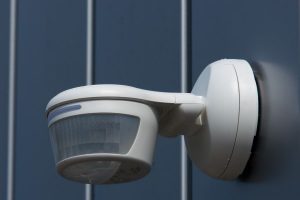The use of motion detectors to keep an eye on the public has been increasing steadily over the past decade. These ubiquitous pyroelectric eyes (passive infrared sensors) can detect everything from thieves breaking into a house to when customers enter the supermarket. Early designs were unreliable, as they would often time out, leaving the operator trying to figure out how to re-trigger the system to turn it back on. Better materials, sensors, processors, lenses and system designs are now making motion detectors more useful. Using passive infrared sensors are at the heart of virtually every low-cost motion detecting system being made today.
Passive Infrared sensors (PIRs) are electronic devices which are used in some security alarm systems to detect motion of an infrared emitting source, usually a human body. Though, all objects, living or not, whose temperature is anything above absolute zero emit infrared radiation.
The term ‘passive’ in this instance means the PIR does not emit any energy of any type, but, merely sits ‘passive’ accepting infrared energy through the front of the sensor, known as the ‘sensor face’. At the core of a PIR sensor is a solid-state sensor, or set of sensors, made from pyroelectric materials – materials which generate energy when exposed to heat. The senor is often manufactured as part of an integrated circuit.
energy through the front of the sensor, known as the ‘sensor face’. At the core of a PIR sensor is a solid-state sensor, or set of sensors, made from pyroelectric materials – materials which generate energy when exposed to heat. The senor is often manufactured as part of an integrated circuit.
An intruder entering the protected area is detected when the infrared energy emitted from the intruder’s body is focused by a Frensel lens or a mirror segment and overlaps a section on the chip which had previously been looking at some much cooler part of the protected area.
When the sensor is idle, both slots detect the same amount of IR, the ambient amount radiated from the room or walls or outdoors. When a warm body like a human or animal passes by, it first intercepts one half of the PIR sensor, which causes a positive differential change between the two halves. The portion of the chip is now much warmer than when the intruder wasn’t there. As the intruder moves, so does the hot spot on the surface of the chip. This moving hot spot causes the electronics connected to the chip to de-energize the relay, operating its contacts, thereby activating the detection input on the alarm control panel.
Motion detectors are typically small and hide in places that seem to be out of the way. As a result, their components are even smaller. Universe Optics manufactures precision lenses to fit into the smallest of motion detectors. They are designed and manufactured to ensure the clearest reading possible per your intricate specifications.
Outside of security systems, there are other applications where PIR’s are used.
Automatic door opening systems
The main aim is to open and close doors in places where a person’s presence is mandatory, for instance, hotels, shopping malls, theatres etc.
Human detection robot using PIR sensors
The human detection robot using passive infrared sensors can be used to detect people stuck in debris after an earthquake or other natural disaster. It gives emergency personnel ‘eyes’ to see under rubble, thereby saving valuable time and saving lives.
Passive infrared sensors can be used in almost any application where motion detection is being necessary. Universe Kogaku designs and manufactures optical lenses for motion detection, security, high tech and electronic applications. We stock 1000’s of standard lens assemblies and can custom design a solution for scanners, CCTV, CCD/CMOS, medical imaging, surveillance systems, machine vision and night vision systems.